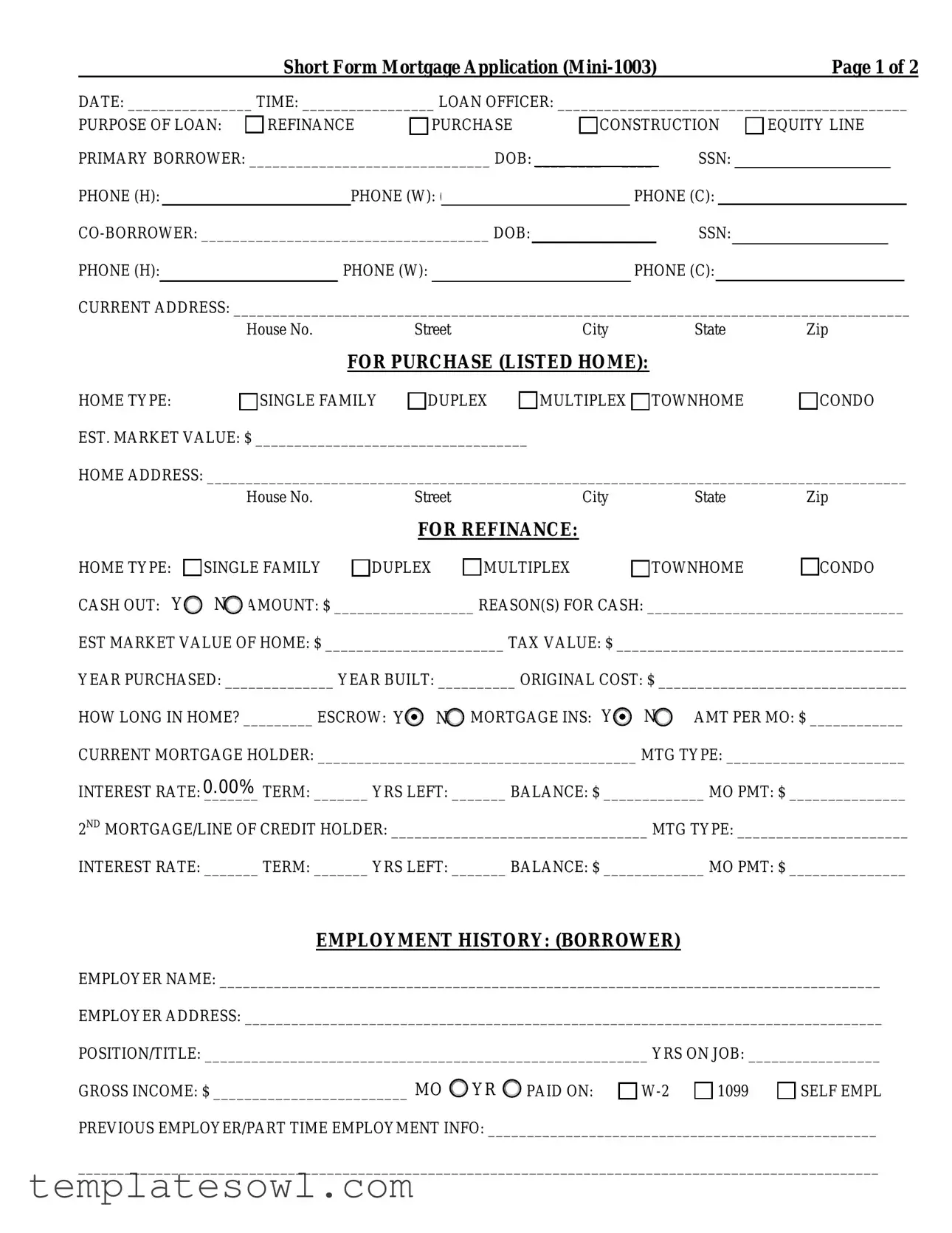|
|
|
|
Short Form Mortgage Application (Mini-1003) |
|
|
Page 1 of 2 |
DATE: ________________ TIME: _________________ LOAN OFFICER: _____________________________________________ |
PURPOSE OF LOAN: |
REFINANCE |
PURCHASE |
|
CONSTRUCTION |
EQUITY LINE |
PRIMARY BORROWER: _______________________________ DOB: ____/____/19____ |
SSN: ______-____-________ |
PHONE (H): (______) ______-_________ PHONE (W): (______) ______-__________ PHONE (C): (______) ______-_________ |
CO-BORROWER: _____________________________________ DOB: ____/____/19____ |
SSN: ______-____-________ |
PHONE (H): (______) ______-________ PHONE (W): (______) ______-___________ PHONE (C): (______) ______-_________ |
|
|
|
|
|
CURRENT ADDRESS: _______________________________________________________________________________________ |
|
|
|
|
House No. |
|
Street |
|
|
City |
State |
Zip |
|
|
|
|
|
FOR PURCHASE (LISTED HOME): |
|
|
|
|
HOME TYPE: |
|
|
SINGLE FAMILY |
DUPLEX |
MULTIPLEX TOWNHOME |
CONDO |
EST. MARKET VALUE: $ ___________________________________ |
|
|
|
|
|
|
HOME ADDRESS: __________________________________________________________________________________________ |
|
|
|
|
House No. |
|
Street |
|
|
City |
State |
Zip |
|
|
|
|
|
|
FOR REFINANCE: |
|
|
|
|
|
HOME TYPE: |
SINGLE FAMILY |
DUPLEX |
MULTIPLEX |
TOWNHOME |
CONDO |
CASH OUT: Y / N |
N |
AMOUNT: $ __________________ REASON(S) FOR CASH: _________________________________ |
|
Y |
|
|
|
|
|
|
|
|
|
|
|
EST MARKET VALUE OF HOME: $ _______________________ TAX VALUE: $ _____________________________________
YEAR PURCHASED: ______________ YEAR BUILT: __________ ORIGINAL COST: $ ________________________________
HOW LONG IN HOME? _________ ESCROW: Y / NN MORTGAGE INS: Y / N N AMT PER MO: $ ____________
CURRENT MORTGAGE HOLDER: _________________________________________ MTG TYPE: _______________________
0.00%
INTEREST RATE: _______ TERM: _______ YRS LEFT: _______ BALANCE: $ _____________ MO PMT: $ _______________
2ND MORTGAGE/LINE OF CREDIT HOLDER: _________________________________ MTG TYPE: ______________________
INTEREST RATE: _______ TERM: _______ YRS LEFT: _______ BALANCE: $ _____________ MO PMT: $ _______________
EMPLOYMENT HISTORY: (BORROWER)
EMPLOYER NAME: _____________________________________________________________________________________
EMPLOYER ADDRESS: __________________________________________________________________________________
POSITION/TITLE: _________________________________________________________ YRS ON JOB: _________________
GROSS INCOME: $ _________________________ (MO / YR ) PAID ON: |
W-2 |
1099 |
SELF EMPL |
YR |
|
|
|
PREVIOUS EMPLOYER/PART TIME EMPLOYMENT INFO: __________________________________________________
_______________________________________________________________________________________________________
Short Form Mortgage Application (Mini-1003) |
Page 2 of 2 |
EMPLOYMENT HISTORY: (CO-BORROWER) |
|
EMPLOYER NAME: _____________________________________________________________________________________
EMPLOYER ADDRESS:__________________________________________________________________________________
POSITION/TITLE: _________________________________________________________ YRS ON JOB: _________________
GROSS INCOME: ___________________________ ( MO / YR ) PAID ON: |
W-2 |
1099 |
SELF EMPL |
MO |
|
|
|
PREVIOUS EMPLOYER/PART TIME EMPLOYMENT INFO: __________________________________________________
_______________________________________________________________________________________________________
REVOLVING DEBT/MONTHLY OBLIGATIONS:
Majority of this information will be obtained via the credit report.
DO YOU PAY CHILD SUPPORT OR ALIMONY?: YY / N N |
AMOUNT/MO: $ ________________________ |
REAL ESTATE TAXES: Y / N N |
YEARLY: $ ___________ |
MO (IF KNOWN): $ ______________________ |
HOME INSURANCE: Y / NN |
YEARLY: $ ___________ |
MO (IF KNOWN): $ ______________________ |
CREDIT HISTORY: EXCELLENT GOOD AVERAGECHALLENGED
AGREE TO CREDIT CHECK: |
Y |
N |
|
SCORE: ________________ |
|
/ N DATE: ____________ TIME: ___________ |
|
HAVE YOU HAD ANY LATE PAYMENTS ON YOUR MORTGAGE (PAST 12 MO) |
Y |
Y / N |
|
|
|
N |
DESCRIBE CREDIT ISSUES (JUDGEMENTS, BANKRUPTCY, COLLECTIONS): _________________________________
_______________________________________________________________________________________________________
ASSETS:
CASH IN BANK ACCOUNTS (include savings & checking): ______________________________________________________
INVESTMENTS (including 401K, brokerage accounts, stocks, bonds Etc…): __________________________________________
PROPERTY (including rental units, cabins, 2nd homes & land): _____________________________________________________
NOTES:
________________________________________________________________________________________________________
________________________________________________________________________________________________________
________________________________________________________________________________________________________
________________________________________________________________________________________________________
________________________________________________________________________________________________________
________________________________________________________________________________________________________
________________________________________________________________________________________________________
